7 Major Ports of the United States
The United States of America has a major shipping presence across the American continent. It covers 75% of its goods transportation that travels through the sea routes. A total of 50 ports across the USA counted a record of 2363 million MT of cargo handling in 2019.
Historically, the USA has had a strong presence in shipping since the early 1600s. However, commercial cargo operations took a great boost from 1820.
With the global uprise of the United States, merchant cargo trading since 1952 portrayed a steady rise. Along with Canada, the US takes the North American shipping share to 44% of the total world count.
Meanwhile, shipping contributes 26% of the country’s economy through direct and indirect trading. In the last decade, US shipping showed a growth of 6.9% in terms of cargo handling volume.
The United States ranks second amongst the countries with the largest Exclusive Economic Zone. It has an active zone of 11,351,000 sq. km.
5 major ports of the USA crosses 3-figures regularly in terms of cargo handling tonnage (Million MT). Meanwhile, a total of 7 ports together handle 47% of the total seaborne cargo.
Today we review these 7 major ports along with the cargo patterns, location, and operational patterns. These facilities also share sea trading routes with partners across Asia, Africa, and Australia.
Port of Houston (Texas, USA)
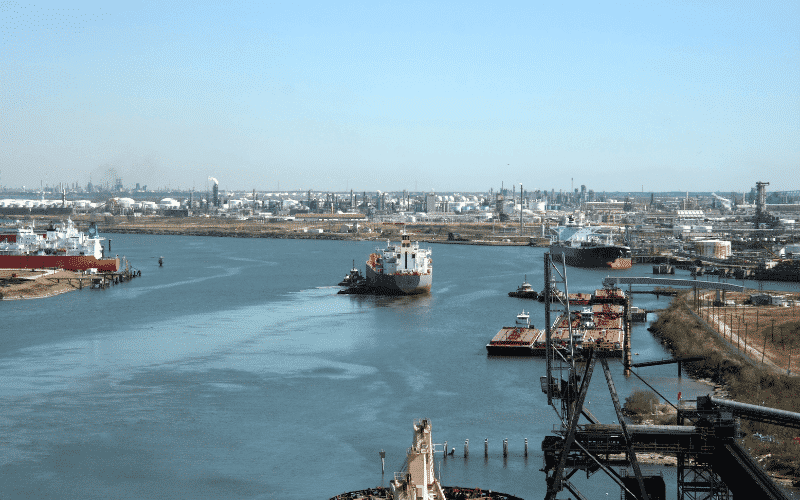
The port of Houston amounts to 284.9 million MT of cargo movement, both inward and outwards of the US. This makes it the busiest foreign tonnage handling port in the entire country. Moreover, it is also the 10th busiest port facility on the global rankings.
The port was established in 1914 along the Houston downtown harbour. At present, the facility covers an area of 50 miles, as far as Morgan’s point. Amongst all the ports in the USA, Houston handles 2.5 times more cargo, except for South Louisiana.
Cargo Handling
The port has an average of 7,800 to 8,500 calls of sea-going vessels every year. Hence, the total direct trade value of this port’s operations amounts to $159.8 billion annually.
There are a total of 9 public terminals, with 2 container terminals and 5 general cargo operation terminals. The channel width is 106.5 meters with a maximum depth of 11.4 meters.
The Bayport cargo operations go through 6 Neo-Panamax and 6 Post-Panamax cranes. Meanwhile, the Barbours terminal operates with 42 RTG, 2 Panamax, 5 Post-Panamax, and 7 Neo-Panamax cranes.
Network and Layout
The Houston port network is the largest in terms of container handling on the US Gulf line. Moreover, the 52 heavy-lift docks spread through the layout cover different roles.
The network consists of more than 200 small and big operators with public and private origin. A total of 795,000 jobs in the operational facility cover the port’s operational requirements. The land transport of cargo takes place through the web-like Houston railway network and trucks.
Port of South Louisiana (Laplace, USA)
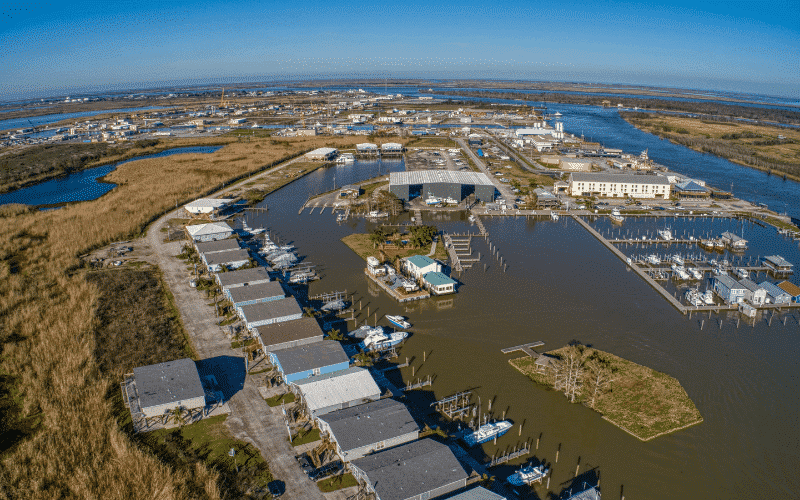
The port of South Louisiana has been in existence since the early 1700s, with cargo operation in function since the 1940s. It ranks next to the Port of Houston in terms of overall cargo tonnage in million MT. Moreover, South Louisiana handles 60% of all the grain cargo handling that takes place in the Midwest.
The facility spreads just over 54 miles, being one of the biggest and widespread ports in the USA. Both the ends for its extension cover between New Orleans and Baton Rouge.
The port recorded 11.9% growth over the last decade, a crucial mark in terms of contribution to the nation’s economy. Its location beside the Mississippi River gives it the highest traffic density amongst the US river ports.
Cargo Handling
South Louisiana Port recorded 238 million MT of cargo handling in the last calendar year. The facility has a total of 13 available berths and handles over 4000 sea-going vessels every year. The maximum draft has a restriction of 13.5 to 15.2 meters available depth at different berths. Their cargo handling features a mix of breakbulk, dry bulk, container, and liquid cargo operations. The facility handles 25% of all the oil cargo that moves across the US.
Network and Layout
The superport acts as the starting point for a pipeline service almost 640 miles long. This network carries 800 barrels of oil from the facility to the different parts of the US. 3 major highways (Interstate 10, 55 and 59) links this port to every major destination in the US too.
Port of New York, NY, and NJ (New York, USA)
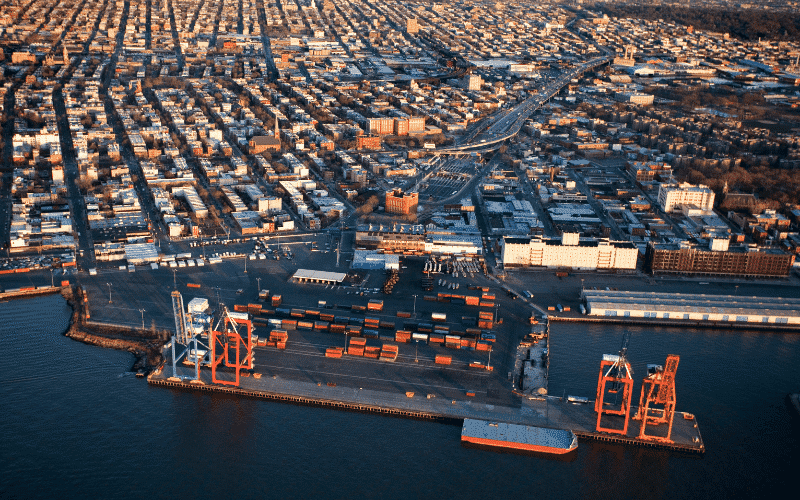
The port of New York and New Jersey encloses the entire coastal area of the New York Harbour. This facility spreads over an area of 25 miles and is the largest natural harbour globally. It has direct access through the Atlantic with a channel surface of 640 miles leading to the complex.
The expansion of 1609 is the pivotal point and leading factor of the increase in incoming traffic for the port. However, the main boom started from the year 1910, ranking it as the busiest global port. A net annual turnover of $5.5 billion makes it one of the most profitable ports in the USA. 23.5% of the port’s trade takes place with China, while India sits second at 8.1%.
Cargo Handling
In 2019, the facility recorded a total of 136.6 million MT cargo handling figures. This consists of 41 million MT of general and 45 million MT of bulk cargo operations. The facility also handled 7,471,131TEU imports in the same year and exports of 7,179,788 TEU. A total of 570,023 vehicle units also arrived at the facility with a US market share of 46%. The facility has a total of 9 terminals with maximum quay lengths of 3087 meters. A total of 6 mega berths have draft restrictions up to 15.2 meters for super container handling.
Network and Layout
The facility is spread across a network of 17 counties with 10 of them completely under its supervision. Hence, it shares more than 50% of the total North Atlantic TEU movement. The express rail network has more than 400,000 handling tasks on an annual basis for container movement. Meanwhile, smaller vessels amount to 24% canal and inland movement of bulk goods. A team of 7000 employees is responsible for year-long handling and terminal operations.
Port of CORPUS CHRISTI (Texas, USA)
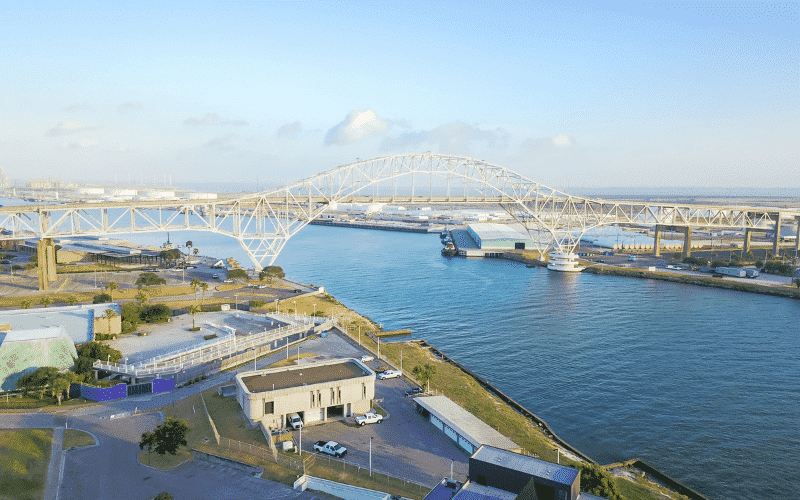
The Port of Corpus Christi stands amongst the few ports in USA with an energy conservation blueprint. Its establishment dates back to the year 1926, being the major terminal for crude oil and gas.
An average depth of 14 meters allows oil-carrying vessels of all sizes to arrive freely. The facility has 50 hectares of common storage area and divides into 2 parts for alongside operations. 6 terminals, namely the North, South, Liquid, Bulk, RO-RO, and La Quinta, operate for seagoing traffic. The port also has a 1500 PSI bearing capacity to stand as the strongest amongst the Gulf ports. A section of the facility also has military units with the US NAVY base since the year 1997.
Cargo Handling
The port handles an average of 100 million MT of cargo, with figures of 111 million MT recorded in 2019. 80% of this is in the form of crude oil and petroleum products handling at the oil terminals. On average, the facility sees more than 6500 vessels of all sizes every year. The grain cargo elevator has 36 concrete silos and an adjacent site for 5,000,000-bushel storage. For dry cargo, the belts handle over 1500 MT of cargo per hour. Meanwhile, the gantries also have a capacity of handling 600 MT per hour.
Network and Layout
The North Terminal Network has rail ramps for direct transfer of ro-ro cargo. Meanwhile, dock 8 on the Southside is the strongest amongst the open wharf designs. The terminal also has 9300 sq. meters of refrigeration and storage capacity for sensitive cargo handling
Port of BEAUMONT (Texas, USA)
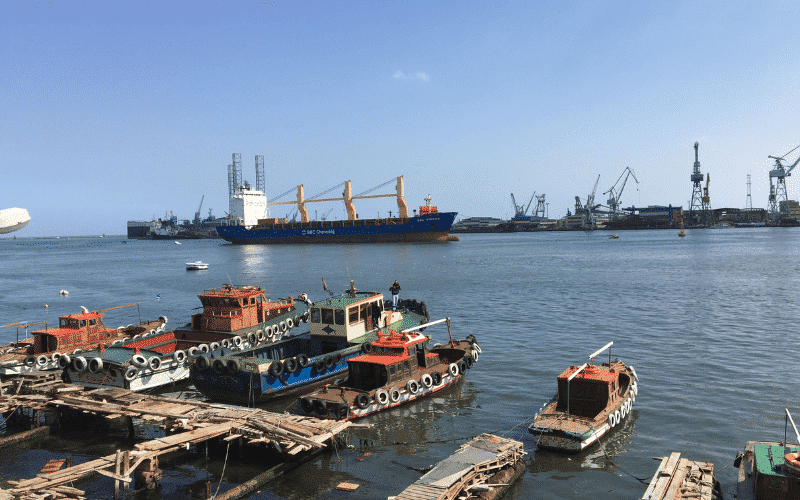
The port of Beaumont exists since 1908, with primary operations of military nature. However, timber cargo operations were the first commercial ones at the facility in 1912. This facility covers an area of 150 sq. miles and has annual revenue of $2.2 billion through commercial shipping. It one of the few ports in the USA to entertain both merchant and defense fleet! Hence, it is also an important base for handling military goods and manufacturing products.
Cargo Handling
The facility is alongside the Sabine-Neches Waterway which is the major route of incoming US oil cargo. The waterway handles 57% of the total petroleum transport along with 14% of gasoline cargo across the country. The last annual statistics of the port reflects 2,070,665 MT of dry and 596,211 MT of breakbulk handling. The remaining part consisted of oil cargo amounting to 101 million MT of total cargo in the year 2019. The grain elevator has a total capacity of 3.5 million and is the best in its class. Daily loading and discharging operations take place across 12 available berths throughout the day.
Network and Layout
The port connects with 3 major railway networks, including the Southern and Pacific railway. Hence, more than 1860 employees hold permanent positions for cargo and port operations. The network consists of a large-scale storage space of 600,000 sq feet for all goods.
Port of New Orleans (New Orleans, USA)
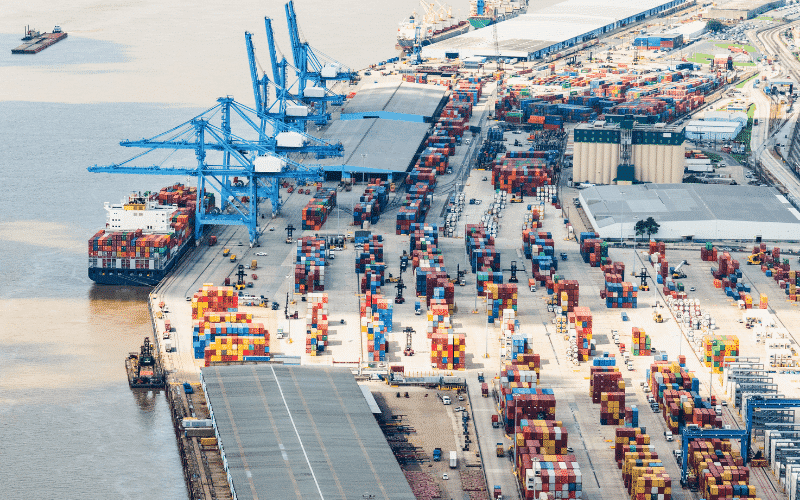
The Port of New Orleans is in existence since 1896 for handling vessel traffic across the Mississippi River. It connects a wide network of 14,500 miles of trading waterways to the coast of America. The facility has over $100 million of profit in turnover attributing to its cargo and rail operations.
It is also one of the busiest ports in the USA with an average of 36000 vessel calls every year. Almost 41.6% of these vessels handle the inward and outward movement of dry bulk cargo. The main Avenue complex is in a built-up area of more than 16,000 sq. m.
Cargo Handling
The facility has two major berths spreading across an area of 2000 feet. This arrangement spreads over an area of 65 acres to handle temporary cargo storage. Moreover, 6 gantries are responsible for container handling operations of all sizes. These terminals also have an on-dock connectivity feature through railway services. In 2019, the port of New Orleans recorded figures of 92.2 million MT cargo handling. This includes 26.9 million MT of domestic bulk cargo goods too.
Network and Layout
An average of 2,000 trucks is responsible for network handling of internal cargo transport. The facility also provides direct alignment for deep-sea vessels to offload with rail services. The tier 3 rail network connects with Tier 1 for seamless transport round the clock. This spreads through an internal rail length of 26 miles with inter-nodal services of 75 miles.
Port of Long Beach (Ocean Blvd., Long Beach, USA)
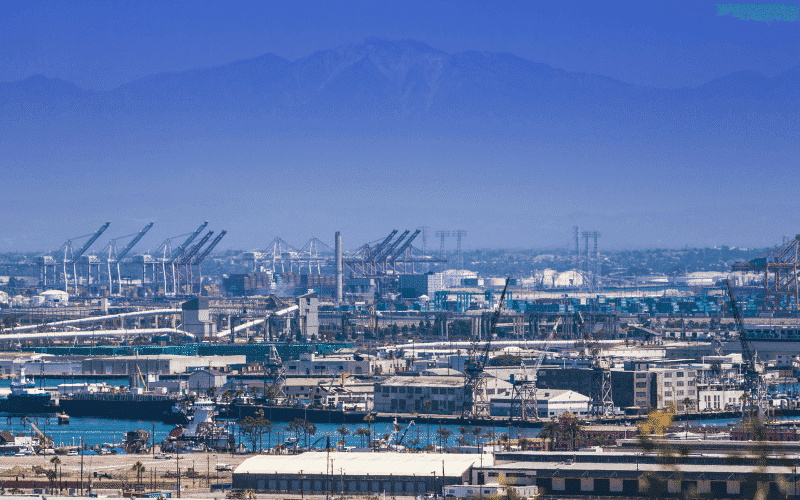
The port of Long Beach was the second-largest container handling terminal in 2019 within the USA. Located behind its neighbour- the Los Angeles port, the facility handles 80-85 million MT at present. This showed 25% of overtaking growth across the last decade. A total of 3.2 km operational region is available for active container operations. Cargo operations in the port started in 1911. At present, it combines with the corridor of Los Angeles port to create the San Pedro Bay.
Cargo Handling
The port facility has a total of 80 operational berths with 10 cargo piers across its expanse. These modern facilities recorded 8,113,315 TEU handling in 2019. The annual value of cargo from the container business amounted to $56 billion. An average of 50 feet depth is available for container vessels. Meanwhile, the largest vessel to arrive at the terminal had a draft of 20.1 meters. Such facilities place it amongst the few ports in the USA with such high drafts.
Network and Layout
Over 100 miles of railway facility connects the port and its internal network for direct handling. This allows the transport of containers of standard sizes to port alongside each other. More than 50,000 annual jobs come from the in-port working and operations for cargo handling. The green port policy allows an 88% reduction in the overall emissions, the second-best in the entire country.
Rapid Growth of the USA Port Network
25% of the USA’s Sea cargo operations with China reflect a strategic growth vision. This comes with 16% of trade relations exclusively with European outlets. With growing relations along Indian harbours and Africa, the global outreach of the USA is evident. Hence, the major ports in the USA play a pivotal part in the steady development of its economy. Over 45 billion worth of expenses for the growth of these facilities are meant for the expansion of the network.
You might also like to read:
- 7 Major Ports in The United Kingdom
- 10 Major Ports in Europe
- 10 Major Ports in France
- 10 Major Ports In India
- 10 Major Ports In China
Disclaimer :
The information contained in this website is for general information purposes only. While we endeavour to keep the information up to date and correct, we make no representations or warranties of any kind, express or implied, about the completeness, accuracy, reliability, suitability or availability with respect to the website or the information, products, services, or related graphics contained on the website for any purpose. Any reliance you place on such information is therefore strictly at your own risk.
In no event will we be liable for any loss or damage including without limitation, indirect or consequential loss or damage, or any loss or damage whatsoever arising from loss of data or profits arising out of, or in connection with, the use of this website.
Do you have info to share with us ? Suggest a correction
Disclaimer :
The information contained in this website is for general information purposes only. While we endeavour to keep the information up to date and correct, we make no representations or warranties of any kind, express or implied, about the completeness, accuracy, reliability, suitability or availability with respect to the website or the information, products, services, or related graphics contained on the website for any purpose. Any reliance you place on such information is therefore strictly at your own risk.
In no event will we be liable for any loss or damage including without limitation, indirect or consequential loss or damage, or any loss or damage whatsoever arising from loss of data or profits arising out of, or in connection with, the use of this website.
Latest Maritime Knowledge Articles You Would Like:
Daily Maritime News, Straight To Your Inbox
Sign Up To Get Daily Newsletters
Join over 60k+ people who read our daily newsletters
By subscribing, you agree to our Privacy Policy and may receive occasional deal communications; you can unsubscribe anytime.















